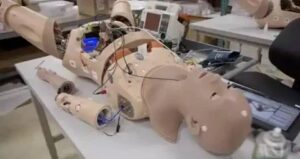
In the rapidly evolving world of medical education and training, the emergence of highly advanced patient simulators has been a game-changer. One such revolutionary tool is Victoria, a state-of-the-art “patient” that is redefining how future healthcare professionals develop their skills.

Developed by Gaumard Scientific, a leading provider of high-fidelity patient simulators, Victoria is an incredibly realistic representation of a human patient. From her lifelike skin and responsive vital signs to her ability to experience complex medical scenarios, this simulator is poised to transform the way medical students and professionals hone their expertise.

Recently, the Wall Street Journal’s Tanya Rivero had the opportunity to witness Victoria in action, as she went through an emergency C-section procedure as part of a medical training exercise. The level of detail and realism on display was truly remarkable, providing a glimpse into the future of healthcare education.

Victoria’s advanced capabilities extend far beyond a standard patient mannequin. She can simulate a wide range of medical conditions, from pregnancy complications to traumatic injuries, allowing trainees to practice their clinical skills in a safe and controlled environment. Her physiological responses, such as breathing patterns and heart rate, can be programmed to mimic real-life scenarios, ensuring that learners encounter challenges that closely mirror what they will face in the field.
One of the key advantages of using Victoria in medical training is the ability to provide immediate feedback and assessment. Instructors can monitor the trainee’s performance in real-time, providing guidance and constructive criticism to help improve their decision-making and technical proficiency. This valuable feedback loop helps to bridge the gap between textbook knowledge and practical application, preparing future healthcare providers for the demands of their profession.

As the healthcare industry continues to evolve, the need for highly skilled and adaptable professionals has never been greater. Tools like Victoria are at the forefront of this transformation, empowering medical students and clinicians to hone their skills, enhance patient safety, and ultimately deliver the highest level of care.

Through the use of advanced patient simulators, the future of medical education is poised to become more immersive, engaging, and effective, ultimately leading to better outcomes for patients and the healthcare system as a whole.











